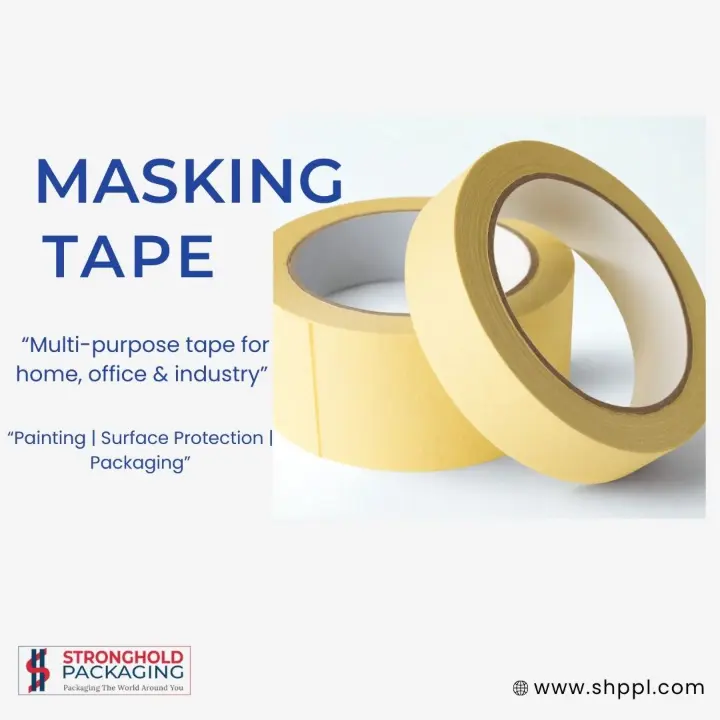Most plants treat masking tape like stationery—until residue, paint bleed, or fiber tear triggers rework minutes you never budgeted. The difference between a “cheap roll” and a reliable industrial grade is the process behind it. Here’s a transparent look at how Stronghold Packaging’s Masking Tape is engineered—from base paper to finished roll—and how each step protects your finish, your audits, and your cost per job in Gujarat’s high-volume facilities.


From Paper to Performance: Step-by-Step Inside the Roll
1) Base Paper Selection & Creping
It starts with select paper (typically 54–70 GSM) that’s creped—micro-folded—to deliver conformability and stretch. Creping provides controlled elongation so the tape bends around curves and edges without splitting. Crepe ratio is tuned so you can hand-tear cleanly yet keep line integrity during removal.
2) Saturation for Wet Strength
The paper is latex-saturated to improve internal bond and moisture resistance. This prevents edge fuzzing and delamination when you apply the tape on humid docks, near wash booths, or during cleaning cycles.
3) Backsize/Release System
A thin release backsize is applied to the rear of the paper. This controls unwind force, stops layers from sticking together in the roll, and ensures a smooth, low-noise dispense—critical for meeting health & safety norms on long shifts.
4) Adhesive Formulation & Coating
Two families dominate professional masking tapes:
Natural rubber–resin (solvent/hotmelt) for instant tack and strong grab on recycled cartons, metals, and epoxy panels.
Acrylic for clean removal and better UV/aging stability in longer dwell.
Adhesive is coated with precise coat weight (g/m²) control to balance tack vs. shear—the science behind “sticks fast, releases clean.” Knife-over-roll or gravure systems lay the film, followed by oven drying to set performance.
5) Slitting & Rewinding
Master jumbos are slit into your working widths—12, 18, 24, 36, 48, 72 mm—and rewound on 3″ cores with ±2% meterage tolerance so dispensers and table-top cutters run consistently.
6) Conversion Hygiene & Packing
Edge dust is removed; rolls are moisture-protected for Gujarat’s monsoon months. Each carton carries batch labels for traceability—handy during audits or line investigations.
The Specs You Actually Use (Without a Dump)
Thickness Window: ~80–150 μm depending on grade.
Adhesive Systems: Rubber–resin for fast grab; acrylic for clean removal/UV stability.
Temperature Ratings:
General purpose: up to ~60–80 °C short exposure (QC, kitting, temporary closures).
High-temperature: 110–160 °C for paint-bake/booth cycles (automotive/engineering).
Clean Removal: Designed to peel without residue or fiber tear within recommended dwell times.
Shelf Life: ~12 months in cool, dry storage.
Compatibility: Hand dispensers, table-top dispensers; printable surface for batch/date notes.
Quality Gates that Protect Your Finish
Every step above is verified through shop-floor-relevant tests:
Adhesion to Steel (ATS): Confirms initial tack—why your team doesn’t “double press” edges.
Shear Resistance: Ensures the tape won’t creep during heat or airflow in paint booths.
Unwind Force & Noise: Operator comfort and consistent application—no jerks that cause wrinkles.
Residue & Fiber Tear Audits: Peel tests from painted metal, stainless, epoxy panels, and coated boards across dwell intervals.
Temperature Cycling: Verifies clean release post bake (110–160 °C grades) or after warm conveyors.
Edge-Bleed Checks: Masking line integrity to prevent paint creep on curves and tight corners.
Translation for your floor: fewer touch-ups, faster changeovers, and a safer path through QA audits.
Rubber–Resin vs. Acrylic: Choose by Surface, Heat & Time
Rubber–Resin (Solvent/Hotmelt)
Where it shines: Recycled/carton fiber, raw metals, epoxy-coated structures, quick jobs under 24 hours.
Why you’ll like it: Strong quick-stick saves seconds per part or carton; great for QC flags and kitting.
Acrylic
Where it shines: Painted panels, plastics, and surfaces where clean removal after days matters; moderate heat exposures; UV-facing areas.
Why you’ll like it: Low residue risk on sensitive finishes; stable performance in warehouses with temperature swings.
High-Temperature Grades (110–160 °C)
Formulated for automotive paint booths, powder-coat prep, and engineering touch-ups. Edge seal and shear are tuned to prevent lift under airflow while still releasing cleanly post-bake.
Gujarat Floor Story: Minutes Saved Become Money Saved
“We had random paint lifts on guard rails and conveyors after maintenance masking. Switching to Stronghold’s high-temp 24 mm for booths and medium-tack 48 mm for QC reduced rework by 18%. The big win was predictability—clean peel even after a weekend dwell.”
— N. Joshi, Operations Manager, Sanand Auto-Paint Line
Their SOP now specifies surface check → grade selection → max dwell time → 45° peel angle. Complaints dropped, audits sped up.
Sector-Wise Fit (Because One Roll Can’t Do Every Job)
FMCG/E-commerce: Medium-tack general-purpose for temporary carton closure during QC; color-tinted versions for visual management and date coding.
Pharma & Clean Ops: Low-residue acrylic for stainless and epoxy in controlled zones; printable surface for calibration tags.
Automotive/Engineering: High-temp (110–160 °C) for booths; narrow widths (12–24 mm) for thread protection and sharp lines.
Electronics/Electricals: Medium-tack for panel marking and harness positioning (not a soldering substitute).
Interiors/Construction: UV-stable “blue tape” styles for 7–14-day clean removal on cured paint.
Fast Selection Checklist (60-Second Procurement Guide)
Surface energy: Fresh paint/varnish → low-tack acrylic; epoxy/steel → medium rubber–resin.
Heat & time: If there’s any bake or >24-hour dwell, choose the rated grade and follow dwell guidance.
Finish risk: Premium panels? Prioritize clean-removal acrylic.
Process step: QC/kitting (writable) vs paint booth (high-temp) vs long-hold (acrylic).
Trial: Always run a short dwell/peel test; we provide sample rolls and an SOP template.
Result: fewer SKUs, fewer surprises, faster approvals.
